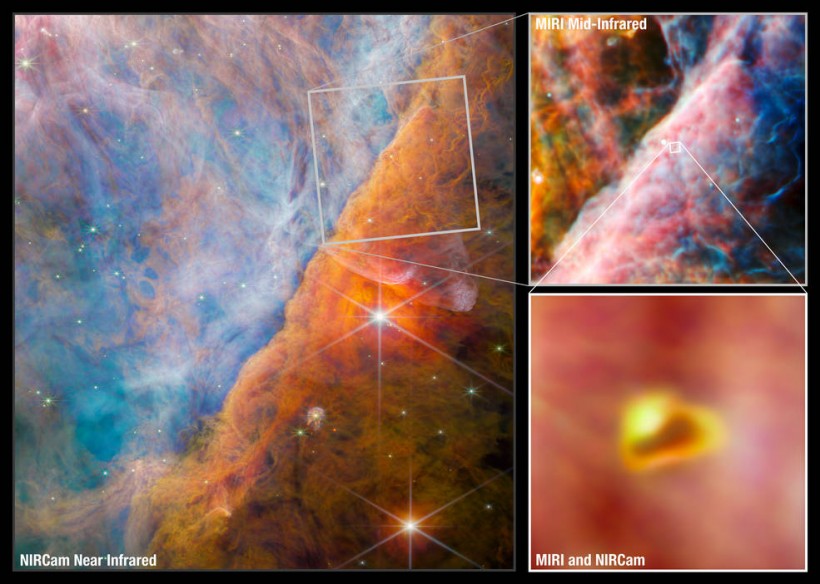In a groundbreaking achievement, a group of international scientists has utilized NASA's James Webb Space Telescope to identify a new carbon compound in space for the first time.
Termed methyl cation (CH3+), this molecule holds significant importance as it contributes to the formation of more complex carbon-based molecules.
Its detection in the d203-506 young star system, accompanied by a protoplanetary disk situated approximately 1,350 light-years away within the Orion Nebula, marks a momentous milestone in our quest to understand the origins and potential existence of life beyond Earth.

The images captured by the Webb showcase a specific segment of the Orion Nebula recognized as the Orion Bar. The primary image, positioned on the left, originates from Webb's NIRCam, which stands for Near-Infrared Camera. Towards the upper right, the telescope hones in on a more confined region employing Webb's MIRI, or Mid-Infrared Instrument. Situated right at the heart of the MIRI region lies a fledgling star system characterized by a protoplanetary disk referred to as d203-506. A magnified view at the bottom right exhibits a composite image derived from both NIRCam and MIRI, capturing the essence of this youthful system.
Building Blocks of Life
Carbon compounds serve as the building blocks of all known life forms, making them a focal point for scientists striving to unravel the origins and possibilities of life within our universe.
According to NASA, Webb's remarkable spatial and spectral resolution and sensitivity significantly contributed to the team's success. The identification of key emission lines from CH3+ by the telescope solidified this groundbreaking finding.
Marie-Aline Martin-Drumel, a member of the science team from the University of Paris-Saclay in France, expressed her enthusiasm, saying, "This detection not only validates the incredible sensitivity of Webb but also confirms the postulated central importance of CH3+ in interstellar chemistry."
Despite the d203-506 star being a diminutive red dwarf, the system experiences intense ultraviolet (UV) radiation from nearby hot, young, massive stars.
Scientists posit that most planet-forming disks undergo a phase of vigorous UV radiation, considering that stars often form in clusters that frequently encompass massive stars capable of producing UV light.
Surprising Find Using NASA James Webb Space Telescope
Conventional wisdom suggests that complex organic molecules would succumb to the detrimental effects of UV radiation. Thus, the discovery of CH3+ may come as a surprise.
However, the team postulates that UV radiation might serve as the catalyst for the formation of CH3+. Once formed, it subsequently initiates a cascade of chemical reactions, leading to the construction of more intricate carbon molecules.
The team also observed notable dissimilarities between the molecules present in the d203-506 system and those commonly found in protoplanetary disks. Particularly noteworthy was the absence of detectable water signatures.
Olivier Berné, the lead author of the study from the French National Centre for Scientific Research in Toulouse, highlighted the implications of these findings, saying, "This clearly shows that ultraviolet radiation can completely change the chemistry of a protoplanetary disk."
Berné added that "it might actually play a critical role in the early chemical stages of the origins of life." The findings of the team were published in the journal Nature.
Related Article: NASA's Hubble Space Telescope Captures 'Butterfly Nebula' In Stunning Motion | Fun Facts About This Beautiful Space Butterfly









